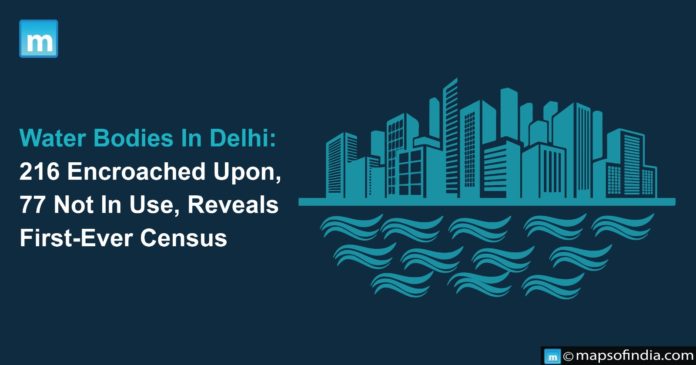The outcome of India’s first water bodies census, a thorough database of the nation’s water bodies, reservoirs, ponds, and lakes, has been made public by the Ministry of Jal Shakti.
Water bodies have been defined as follows in the Census
The term “water body” shall be used in this Census to refer to any natural or artificial units surrounded by some or no masonry construction and used to store water for irrigation or other uses (such as religious, industrial, recreation, domestic/drinking, groundwater recharge, etc.). These often come in various varieties and go by several names, such as tanks, reservoirs, ponds, etc.
The objective of the report
The Census of Water Bodies aims to create a national directory for all water bodies by gathering data on all significant elements of the issue, such as their extent, condition, usage, storage capacity, and state of filling up of storage, among other things.
Also Read:
India’s First-Ever Water Bodies Census Report: Bengal Tops The List; Sikkim At Bottom
The scenario of water bodies in Delhi
- By the Ministry of Jal Shakti’s most recent water bodies census report, of Delhi’s 893 water bodies, 216 (24.19%) are encroached upon. The analysis reveals that 132 water bodies were determined to have been overtaken to a greater or equal extent than 75%.
- The research recognises 14 lakes (bigger and more profound than ponds) but only counts 525 ponds (small water bodies) throughout the city, of which 66 were determined to have been encroached. The most encroached water bodies were found in the ‘others’ category, accounting for 149 of the 349 total.
- According to the research, water bodies are confined on all sides by natural or man-made structures. They are utilised to store water for commercial, religious, and industrial reasons and irrigation and other uses, including groundwater recharging.
- Many of the water bodies (398 of the total) have a holding capacity of 0 to 100 cubic metres, the lowest storage capacity extend that the report considers. Most of the water bodies determined in Delhi possess a water circulating area of fewer than 0.5 hectares, while one was found to be in the 10- to 50-hectare range.
- 176 different bodies of water in Delhi have a combined storage capacity of more than 10,000 cubic metres.
| Water Bodies in Delhi | ||
| Total Water Bodies | In Use | Not in Use |
| 893 | 237 (26.5%) | 656 (73.5%) |
| Purpose of Usage | Reason | |
|
|
|
The standpoint of the environmentalist
According to the Indian Express, on the encroached water bodies, environmentalist Diwan Singh said, “We did a survey in 2011-12 in Southwest Delhi and found that 80% of encroachment was by government bodies… schools, parks. There is little effort to revive these water bodies. The involvement of the local communities is important in preserving and maintaining these water bodies, but the agencies that own these water bodies do not allow community work or participation. There is a scheme now to release treated water from sewage treatment plants into water bodies, but that water does not always meet quality standards.”
Also Read:
First Census Report: List Of Water Bodies In Rural Areas Across India
Moreover, he pointed out that smaller bodies of water, like ponds, are as significant since they are dispersed and may catch rainwater, especially run-off from concrete areas. A High Court-appointed commission reported on the condition of Delhi’s water bodies after inspections from 2007 to 2012 revealed parks on encroaching water bodies.




